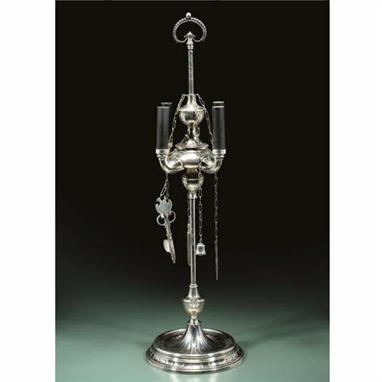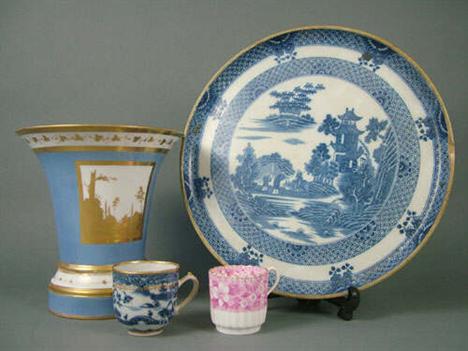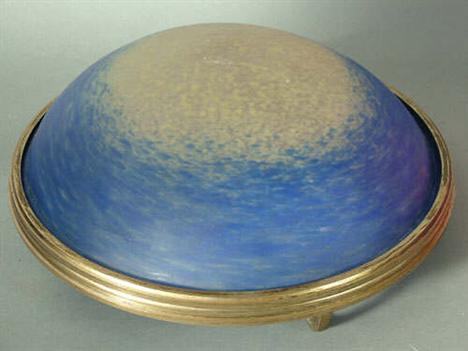534325 Preisdatenbank Los(e) gefunden, die Ihrer Suche entsprechen
534325 Lose gefunden, die zu Ihrer Suche passen. Abonnieren Sie die Preisdatenbank, um sofortigen Zugriff auf alle Dienstleistungen der Preisdatenbank zu haben.
Preisdatenbank abonnieren- Liste
- Galerie
-
534325 Los(e)/Seite
A brass Cheutin oil opera lamp with curved bevelled glass lenses, the side lens with cut multi-pointed star on blue ground, the front lens plain (cracked to corner), and flattened conical oil reservoir mounting for offside use (screw missing), together with a brass Lucas King of the Road back light, no. 638 (clear lens cracked), an Esso promotional petrol tanker and a British Jaeger black faced eight day dashboard clock.
A good heavy baluster goblet circa 1700 the generous funnel bowl with solid base, set on a teared inverted baluster stem and folded conical foot 18.8cm., 7.375in. some very light typical scratching to the interior of the bowl For the form, see the catalogue, 'The Baluster Family of English Drinking Glasses', Delomosne and Son Ltd., May 1985, pp.6-7, fig.1 Provenance With Delomosne and Son Ltd., North Wraxall Private Collection
An Italian silver oil lamp, most probably Gregorio Spinazzi, Rome, circa 1770 circular, with detachable shaft sections, covered four-light oil recepticle, chain-hung snuffer, scissors, pick and tweezers, detachable beaded handle, silver shaft, iron core, wood base, chased with stiff leafage on a reeded ground, fitted for electricity 80cm, 31 1/2in high 3063gr, 98oz 10dwt all in This maker's mark was also used by the Roman goldsmiths Domenico Gabriele Mariani (1697-1756) andÊGiuseppe Nepoti (1677-1753), and continued in use by their widows until 1762.
h.M.S. Aboukir: the presentation ivory mallet used to launch the ship on 16th. May 1900, carved with the monogram G.S.M. for Admiral Sir George Digby Morant and his wife Sophie, and the legend Fairfield Shipbuilding & Engineering Co. Ltd, together with a contemporary photograph of Admiral George Digby Morant. provenance: by direct family descent Admiral Sir George Digby Morant was born in Carrickmacross, County Monaghan in 1837. In 1850 he joined the navy and served in Burma, the Baltic, Crimea and China and was promoted to the rank of Admiral. At Pembroke and Chatham he was Admiral Superintendent of the dockyards overseeing the launch of a number Her Majesty’s Ships. He was knighted and died in London in 1921. hMS Aboukir was a Cressy class cruiser of 12,000 tons built by Fairfield Shipbuilding & Engineering Co Ltd, Govan, Scotland, in 1900. the Cressy-class vessels had rapidly become obsolete due to the great advances in naval architecture in the years leading up to the First World War. At the outbreak of the war, these ships were so clearly unfit for combat that they were mostly staffed by reserve sailors. The Admiralty was planning to withdraw them, when the Aboukir and two of her sisters, the Cressy and Hogue were lost to submarine attack. The Aboukir was one of four units that made up Rear Admiral Henry H Campbell’s Seventh Cruiser Squadron. Owing to the obsolescence of these ships, the squadron was nicknamed the Live Bait Squadron. In September 1914 Aboukir and her sister ships the Hogue and Cressy were patrolling the Broad Fourteens of the North Sea. Owing to poor weather they were without destroyer escort. While steaming at 10 knots in line ahead early morning on 22 September, they were spotted by the U-9, commanded by Lt. Otto Weddigen. Weddigen ordered his submarine to submerge and closed the range to the unsuspecting British ships. At close range, he fired a single torpedo at the Aboukir. The torpedo broke the back of the Aboukir and she sank within 20 minutes with the loss of 527 men. The captains of the Cressy and Hogue thought the Aboukir had struck a floating mine and came forward to assist her. They stood by and began to pick up survivors. At this point, Weddigen fired two torpedoes into the Hogue, mortally wounding that ship. As the Hogue sank, the captain of the Cressy realised that the squadron was being attacked by a submarine, and tried to flee. However, Weddigen fired two more torpedoes into the Cressy, and sank her as well. The entire battle had lasted less than an hour, and cost the British three warships, 62 officers and 1397 ratings. Coming on the heels of the loss of the light cruiser HMS Pathfinder earlier to another submarine attack, this incident established the U-boat as a major weapon in the conduct of naval warfare.
a pair to E.W. Pottington; Defence and British Gas Light Company Limited silver Long Service Medal (named and dated 1926), two School Attendance medals in silver and bronze; together with ARP badge and Hull Dispatch Riders badge 1915, this last rare, all extremely fine in box/case as issued, (6).
four to Major [Sir] W.E. Crum, Calcutta Light Horse, Indian Army: Order of the British Empire (O.B.E.), Civil Division, Officer’s breast badge, type 1; British War Medal; Delhi Durbar, 1911 (unnamed); Volunteer Force Long Service, Geo. V (Major, Cal. Lt. Horse), officially engraved, mounted for wearing, extremely fine; together with a mounted group of 4 dress miniatures, two riband bars and a Calcutta L.H. badge (11) Major Sir Walter Erskine Crum, Kt. Batchelor, O.B.E. (1874-1923). Served as a Major in the Calcutta Light Horse (1913-20) and was both President of the Bengal Chamber of Commerce as well as a Member of the Indian Imperial Legislative Council between 1919 and 1920 (O.B.E., 1918; knighted 1920).
A Victorian lacquered brass monocular microscope, late 19th century, with coarse and fine focus adjustment above adjustable stage hinged onto Y-shaped foot with pivoted mirror and signed BAKER, 244 High Holborn, London to rear, in original mahogany box with light magnifying glass on stand, spare lenses and other accessories, box 45cm high.
An inlaid mahogany mantel timepiece, Unsigned, 19th century The single fusee movement with outside platform lever escapement mounted on the light bulb shaped backplate, with convex silvered brass Roman numeral circular dial in balloon shaped case with satinwood oval cartouche to the concave front, on moulded base with brass bracket feet, 29cm high.
A full size live steam open crank horizontal mill engine, the single cylinder with approximately 2 5/8in bore x 4 1/2in stroke, cross-head guides, eccentric driven steam valve, 24 inch diameter spoked flywheel. The engine has a govenor mounting bracket but has never had a speed govenor fitted from new. Finished in light blue paintwork and mounted on a polished mahogany plinth. Engine base 34inch by 10 1/2 inches.
A 5 inch gauge 0-4-0 battery electric diesel design locomotive Trog, built in 1984 by the late Mr W J (Bill) Manley of Topsham Nr Exeter. The engine was run at Tiverton MES until the last two years. Now requires a new battery. The locomotive is finished in light blue and black livery and comes with a display track. Length 25 inches (63cm).
Selection of china and glassware, to include a Paris porcelain vase on stand with light blue ground and two gilt landscape panels, 18.5cm high, two cut glass vases, Spode blue and white and red and white cups and saucers, printed marks, circular stand decorated in blue and white with a central landscape panel and geometric patterned borders, 29cm diameter, and other items, a/f
John Mollo b.1931- ''A Light Company Officer Of The 1st Regiment Of Foot Guards, In Frock Dress, numbered 77; watercolour, silhouette, signed and dated 63: together with three other similar watercolour silhouette studies of officers each for the ''Mollo's Military Profiles, or Regimental Silhouettes 1800-1830'' each signed and dated 63 and numbered 128,130,84, 18x12cm, oval, each, all bearing Mollo's label verso, (4)
-
534325 Los(e)/Seite













![four to Major [Sir] W.E. Crum, Calcutta Light Horse, Indian Army: Order of the British Empire (O.B.E.), Civil Division, Offi](http://lot-images.atgmedia.com/SR/10011/2712024/515-113-10011_468x382.jpg)




























